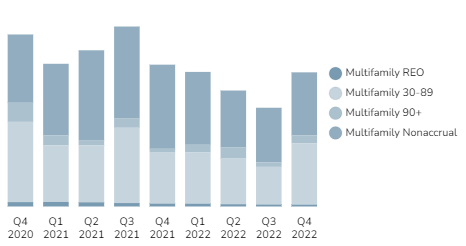
Multifamily loan performance reversed course and saw a massive new surge in distress as we moved into 2023.
Rising from just $546M in new 30-89 day loans in Q3 2022, the fourth quarter saw that number roar to almost $900M while nonaccrual stage loans also grew.
Dive into the BankProspector dashboard to find out which banks are holding the most non-performing notes now.Â
Multifamily
Massive demand for multifamily assets over the past few years appeared to have kept this space solid. There was no lack of appetite or capital for investing in MF.Â
However, latent distress from COVID lockdowns, massive rounds of layoffs, and hyper inflation may now be catching up with landlords and showing up in loan performance.Â
Multifamily loans performance now appears to have erased the past year of improvement, falling back to similar distress levels seen in Q4 2021.Â
Fewer banks may be holding this distressed paper today, with less than 260 banks reporting that they are holding a combined non-accrual stage multifamily mortgage loans.
There are also over $100M in 90 day plus late loans still in the accrual stage, which are held by just 34 banks.Â
Multifamily REO
One area of minor improvement is multifamily REO, falling to just over $27M. Or around 1% of all non-performing multifamily loans on bank books.Â
This is the least multifamily REO we’ve seen banks holding in two years. Though the massive spike in late and defaulting loans, along with difficulty in securing financing, plus higher mortgage rates could mean a significant increase here.Â
That’s if real estate investors and funds are not able to keep on picking up these assets at their previous pace.Â
Looking Ahead
Multifamily debt and income properties are still highly desirable. Perhaps even more so today given the outlook for other areas of the economy and other asset classes.
However, the data does seem to suggest that distress is piling up, and ultimately causing far more borrowers in this space to fall into default. That could spike further if many are unable to refinance loans at maturity as well as if continued migration trends cause high vacancy rates in once prime financial and business hubs.Â
This should be balanced with the fact that some of this may be seasonal along with the urgent need for investors to add more of these types of assets to their portfolios.Â
Log in now to see which banks are holding the most distressed multifamily loan notes…

